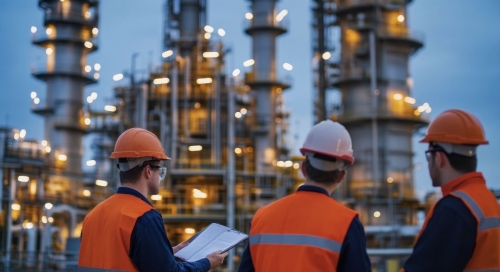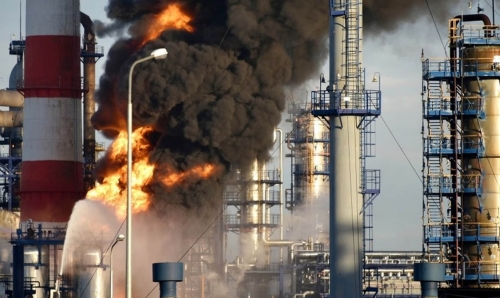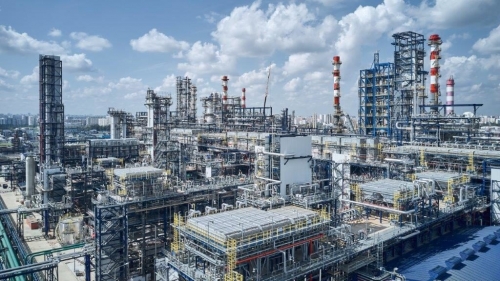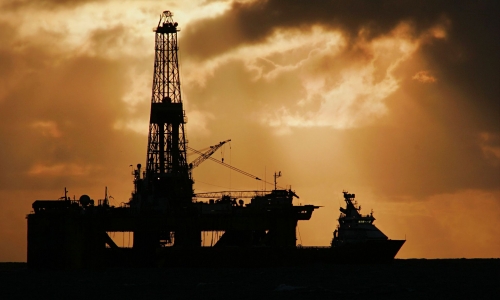Oil prices rose last week to their highest levels since last month, on growing tensions and supply risks related to the Russia-Ukraine conflict.
BKR Rig Count | The total active drilling rigs in the United States increased by 7 last week, to 549. Oil rigs increased by 6 to 424, and gas rigs dropped by 1 to 117. Rig count in the Permian Basin dropped by 1 to 253 | Sept 26 | BKR NAM Rig Count
US Crude Inventories, excluding those in the Strategic Petroleum Reserve (SPR), decreased by 0.6 MMbbl to 414.8 MMbbl (about 4% below the 5y average for this time of year). On the products side, gasoline decreased by 1.1 MMbbl (2% below the 5y average). Distillate fuels decreased by 1.7 MMbbl (8% below the 5y average). Total commercial petroleum inventories decreased by 0.5 MMbbl | Sept 19 | EIA Weekly Report
President Xi Jinping has personally pledged to cut China’s greenhouse gas emissions to 7-10% below peak levels by 2035, while “striving to do better”. This is China’s third pledge under the Paris Agreement, but is the first to put firm constraints on the country’s emissions by setting an “absolute” target to reduce them. Xi’s pledge for non-fossil fuels to make up 30% of China’s energy is far below the latest forecasts, while his goal for wind and solar capacity to reach 3,600 gigawatts (GW) implies a significant slowdown, relative to recent growth | Sept 25 | Carbon Brief
China’s surge in Indonesian imports could suggest workarounds for Iran oil exports, even in the face of US pressure. A total of about 630k barrels a day arrived last month, according to customs data. That follows a jump in July, when flows tripled from the previous month. China’s August purchases would comfortably exceed Indonesian output of about 580,000 barrels a day last year, most of it consumed domestically in a country where demand is close to 1.7 million barrels a day | Sept
Kuwait's crude oil production capacity reached 3.2 mbbl/d, marking the highest level in more than a decade, according to the country’s Oil Minister Tariq Al-Roumi. This follows a peak of 3.3mbbl/d in 2010, before output capacity fell below 3mbbl/d. Kuwait plans to increase its oil production to 2.56mbbl/d from October this year under the OPEC+ agreement | Sept 23 | GlobalData
The imminent restart of Iraq’s northern oil-export pipeline after a two-year dispute was greeted by the market this week with a shrug. “It’s mainly re-directing flows,” Homayoun Falakshahi, a senior analyst at intelligence firm Kpler Ltd., said of the pipeline restart. “I’d say an increment of 50,000 to 100,000 barrels a day on top of current output, maybe.” | Sept 26 | Bloomberg
BP shifts view on oil peak out ~5yrs to 2030 | In its Energy Outlook published Thursday, the major said global oil demand will keep climbing throughout this decade — a shift from its prior projection that the high point could come as soon as 2025. “It’s less about bold views and more about realism: an acceptance that oil will remain central longer than once hoped.” | Sept 24 | Bloomberg, BP
US Shale Bosses Decry ‘Broken’ Business as Trump Wants More Oil | Executive quotes from the recent Dallas Fed report include: “We have begun the twilight of shale,” “The US isn’t running out of oil, but she sure is running out of $60 per barrel oil.”, “Day to day changes to energy policy is no way for us to win as a country,” “The US shale business is broken,” | Sept 24 | Bloomberg
The UK government is planning to grant licences for North Sea tiebacks in a softening of its original plans to ban new licences for oil and gas drilling, according to a report in The Times. Instead of an outright ban on new exploration, North Sea operators will be able to apply for licensing in blocks near to existing infrastructure, a decision that Offshore Energies UK says could help unlock up to 7.3 billion boe. UK government is expected to announce the results of its licensing and fiscal decisions during the autumn Budget scheduled for 26 November | Sept 22 | Upstream
China’s automakers will need permits to export electric vehicles starting next year, adding to signs the country’s officials are tightening their management of the world’s biggest car market. In the first seven months of this year, Chinese carmakers exported more than $19 billion worth of electric-powered vehicles, roughly the same as a year earlier, with Europe the top market despite the EU tariffs | Sept 26 | Bloomberg
North America
Sempra Infrastructure has taken FID on Port Arthur LNG Phase 2 project in Jefferson County, Texas. Phase 2 will add two liquefaction trains with a 13 MMtpa capacity, costing $12 billion plus $2 billion for shared facilities, and commercial operations expected in 2030 (Train 3) and 2031 (Train 4). To recall, Phase 1’s two identical trains are expected online in 2027-2028 | Sept 24 | S&P
Adnoc’s XRG completed its acquisition of an 11.7% equity stake in Phase 1 (Trains 1-3) of the Rio Grande LNG project in Brownsville, Texas, United States (US) The investment is a strategic JV between XRG and Global Infrastructure Partners (GIP), a part of BlackRock, and marks XRG’s first gas investment in the US. Construction of Trains 1-3 continues to progress smoothly, while FID for Train 4 was achieved in early September | Sept 25 | XRG PR, Upstream
Latin America
ExxonMobil has made FID for the Hammerhead development, offshore Guyana. Hammerhead, the seventh project on the Stabroek block, is anticipated to come online in 2029. The development will utilize a floating production storage and offloading (FPSO) vessel with a capacity to produce approximately 150,000 barrels of oil per day. The US$6.8 billion Hammerhead project will include 18 production and injection wells, and bring Exxon’s total investment in Guyana to $60B | Sept 22 | XOM PR
GeoPark has signed a $115 million agreement with Pluspetrol to acquire a 100% stake in Loma Jarillosa Este and 95% operating stake in Puesto Silva Oeste blocks in Argentina's Neuquen basin. The blocks hold over 60 MMbo recoverable, with current production of 1,700–2,000 boe/d (95% oil), increasing GeoPark’s output to approx. 30,000 boepd. GeoPark intends to increase plateau production to around 200,000 boe/d by end-2028, with the potential addition of between 50 and 55 wells across 15 pads | Sept 26 | S&P, Upstream
IBAMA has approved Petrobras’ (op) recent Pre-Operational Assessment (APO), part of the required oil spill response plan (including an on-site wildlife care unit), albeit with the request for adjustments to the wildlife protection plan. To recall, the lack of an APO originally prevented drilling the high-impact Morpho-1 well (with the rig demobilizing two years ago). Timing for the restart of drilling unknown, but Brazil’s Energy Minister stated that the aim is for H1 2026 | Sept 26 | S&P
Europe & Africa
Eni sold a 30% stake in Côte d’Ivoire’s Baleine project to Vitol (leaving Eni 47.25%, Vitol 30%, Petroci 22.75%), adding to their Ghana collaboration (OCTP, Block 4). The move aligns with Eni’s ‘dual exploration’ model of divesting equity to accelerate the monetization of exploration discoveries, similarly seen in large projects like Zohr (Egypt) and Area 4 (Mozambique). Baleine currently produces 62,000 bopd and 75 MMcfg/d from its first two phases, with a third phase targeting 150,000 boe/d and 200 MMcfg/d, positioning its role as a cornerstone in Côte d’Ivoire’s energy supply | Sept 26 | GlobalData, Eni PR
Additional gas volumes from Norway’s Troll field will be made available for export following approval of a new pipeline investment, the Norwegian Offshore Directorate said. Consent was granted to the Equinor-led Troll owners for a pipeline from Troll B to the Kvitebjorn export pipeline to Kollsnes. Gas volumes previously reinjected to improve oil production will now be exported. Start-up is expected Q4 2025. Investments total Nkr1.16 billion (US$115 million) | Sept 26 | Upstream
A deal to restart oil exports from Iraqi Kurdistan to Turkey has been finalised, with several international oil companies saying resumption of exports through the Iraq-Turkey Pipeline (ITP) will start 27 September. Upstream reported signatures were needed from officials in the Iraqi central government before the agreement has full legal force | Sept 25 | Upstream
ExxonMobil unveiled a combined resource estimate of 8 trillion and 9 trillion cubic feet of gas for its giant Glaucus and Pegasus gas discoveries offshore Cyprus, according to the country's Energy Ministry. Pegasus is the second gas discovery made in Block 10, following Glaucus in 2019. A decision on the commerciality of the discoveries will be taken by early 2026. Block 10, offshore southwest Cyprus, is licensed under a JV to ExxonMobil and QatarEnergy | Sept 26 | Upstream
Asia
Honghua Group, a Chinese energy technology company, has reportedly introduced an intelligent fracturing solution designed to enhance the efficiency and automation of unconventional oil and gas extraction. Zhao Chongsheng, who manages the fracturing section at Honghua, said that the new solution integrates intelligent control across six key systems including intelligent power supply and distribution, intelligent electric fracturing pumps, and intelligent safety and fracturing control systems | Sept 24 | GlobalData
Another offshore exploration well has been added to Australia's Otway basin in a crucial drive to rapidly boost the supply of domestic gas by three operators - ConocoPhillips, Beach Energy and Amplitude Energy. Welligence Energy Analytic said that "the Otway could be seeing a new wave of discoveries, with relatively high geological chances of success, as reported by the operators drilling these wells (67-83% chance of success)" | Sept 24 | Upstream
Turkey’s state gas company signed a 20-year liquefied natural gas import deal with Swiss trading house Mercuria Energy Group Ltd., the biggest yet in a flurry of new contracts. From 2026, Botas will import around 4 billion cubic meters per year of US-produced LNG to its home market as well as to Europe and North Africa, equivalent to about 8% of Turkey’s total annual gas demand | Sept 24 | Bloomberg
Looking ahead
S&P Asia and Middle East Crude Oil Markets Long-Term Outlook | Asia continues to rely heavily on crude imports to meet its demand, with dependency on crude imports rising to close to 90% in 2050 from 83% in 2024, as investment in new projects could not keep up with the requirements. There may be near-term support for higher imports of sweet crudes from the US owing to favorable Dated Brent-Dubai spread and political pressure to do so amid the trade negotiations. Crude production is projected to fall from about 6.2 million b/d in 2024 to about 3.7 million b/d on average by 2050, which is about 8% lower in the S&P latest update, primarily driven by low production in China, India, Indonesia, Malaysia, South Korea and Thailand. Even if Asian refinery throughputs are forecast to grow from about 30.4 million b/d in 2024 before peaking in the early 2030s to about 32.8 million b/d and declining to 28.5 million b/d by 2050, the region’s dependency on imports continue to climb through 2050. Conversely, Middle Eastern crude production is expected to grow in the long term to meet rising export demand from developing economies. Crude oil production from the Middle East will continue to grow from about 23.4 million b/d in 2024 to 28.7 million b/d in 2050, while condensate production is likely to increase from about 2.7 million b/d in 2024 to about 3.3 million b/d in 2030 before declining to about 2.7 million b/d by 2050. S&P expects higher Middle Eastern production as OPEC+ rolls back their production cuts in the near term. In the long term, Middle Eastern production will rise to balance fundamentals amid the decline of non-OPEC+ supply. As the regional refinery processing will grow modestly from 9.5 million b/d in 2024 to 10.3 million b/d in 2050, most of the production growth is projected to cater to the export markets. Notably, the share of global crude exports from the Middle East is estimated to increase, indicating the region’s growing importance of supply and pricing | Sept 26 | S&P
Oil traders see OPEC+ agreeing to revive more production in November as the group strives to reclaim global market share. Saudi Arabia and its partners are likely to approve another boost for November, possibly in line with the modest 137,000 barrel-a-day increment scheduled for next month, according to a Bloomberg survey of traders and analysts. Eight key nations will hold a video-conference on Oct. 5. The Organization of the Petroleum Exporting Countries and its allies have started to revive a new layer of halted output, amounting to 1.66 million barrels a day, in monthly stages despite warnings from across the oil industry of an impending surplus. Yet Riyadh feels vindicated after rapidly restarting a previous 2.2 million-barrel tranche in recent months in defiance of bearish predictions. Oil prices weakened only modestly as China scoops up supplies for its strategic reserves, and as the increases announced by OPEC+ haven’t materialized in full. Crude futures traded near $69 a barrel in London on Friday, leaving them down about 7% so far this year. The retreat offers some relief for consumers after years of inflation, and aids US President Donald Trump as he seeks to bring down interest rates and pressure Russia into ending the war in Ukraine. All but three of 21 survey respondents predicted that the eight key OPEC+ nations will increase, with most of those who forecast an approximate volume anticipating a hike of 137,000 barrels a day. Still, Saudi Energy Minister Prince Abdulaziz bin Salman has built a reputation for springing surprises, such as the super-sized hikes used to accelerate the return of the 2.2 million-barrel tranche. Alliance co-leader Russia has largely gone along with the increases, even as sanctions and Ukrainian attacks challenge its energy industry.
OPEC+ delegates have given a range of explanations for swiftly restarting supplies halted since 2023, a move that broke with years of effort to shore up oil prices. People familiar with Riyadh’s thinking have said it hopes to recoup through higher volumes any revenues they lose through lower prices, and recapture the share of world markets ceded over the past few years to rivals like US shale drillers. “The group has embraced a market share strategy,” said Kim Fustier, senior global oil and gas analyst at HSBC Plc. “We are skeptical that OPEC+ will blink unless oil prices fall materially.” By letting OPEC+ open the taps, the kingdom also seeks to demonstrate to oil traders that the group’s other members have considerably less spare production capacity than was generally assumed, shaking out any complacency in the market. A demonstration of this dynamic came this week, as Iraq finally reached an agreement to restart exports through an oil pipeline from its semi-autonomous Kurdish region, shuttered for more than two years. Yet oil prices largely shrugged off the news, as traders suspected that most of the halted production had already been diverted to domestic consumption or nearby countries | Sept 26 | Bloomberg

%20(1).png)



